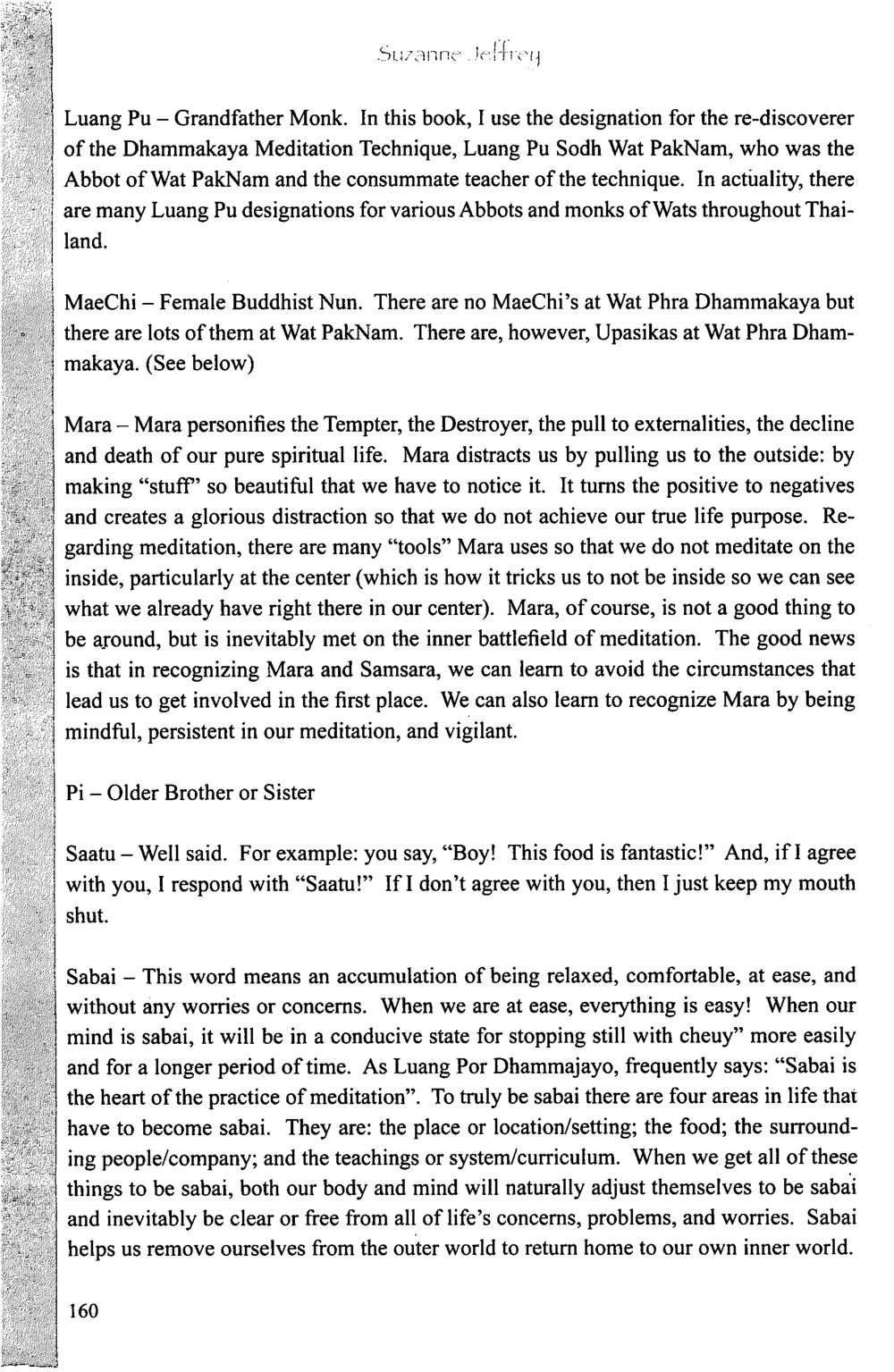Key Concepts in Dhammakaya Meditation : หน้า 159/164
The Meeting with a Dhamma Master : หน้า 159/164 Explore the fundamental concepts and terminologies in Dhammakaya Meditation, including Luang Pu, MaeChi, Mara, and the importance of a 'sabai' state for effective practice.
2 ครั้ง

สรุปเนื้อหา
This text introduces key terms within the realm of Dhammakaya Meditation, focusing on figures like Luang Pu Sodh Wat PakNam and the roles of MaeChi and Upasikas. It delves into Mara as a symbol of temptation and distraction in meditation, explaining how mindfulness can help practitioners recognize and counter these distractions. The concept of 'sabai' is highlighted as essential for meditation, emphasizing the need for a conducive environment and mental state to achieve inner peace and clarity. The importance of being at ease and free from worldly concerns is reiterated in the context of meditation, making the practice more accessible and effective.
หัวข้อประเด็น
-Luang Pu
-MaeChi
-Mara
-Meditation Principles
-Sabai State
ข้อความต้นฉบับในหน้า
Suzanne Jeffrey
Luang Pu - Grandfather Monk. In this book, I use the designation for the re-discoverer of the Dhammakaya Meditation Technique, Luang Pu Sodh Wat PakNam, who was the Abbot of Wat PakNam and the consummate teacher of the technique. In actuality, there are many Luang Pu designations for various Abbots and monks of Wats throughout Thailand.
MaeChi - Female Buddhist Nun. There are no MaeChi's at Wat Phra Dhammakaya but there are lots of them at Wat PakNam. There are, however, Upasikas at Wat Phra Dhammakaya. (See below)
Mara - Mara personifies the Tempter, the Destroyer, the pull to externalities, the decline and death of our pure spiritual life. Mara distracts us by pulling us to the outside: by making "stuff" so beautiful that we have to notice it. It turns the positive to negatives and creates a glorious distraction so that we do not achieve our true life purpose. Regarding meditation, there are many "tools" Mara uses so that we do not meditate on the inside, particularly at the center (which is how it tricks us to not be inside so we can see what we already have right there in our center). Mara, of course, is not a good thing to be around, but is inevitably met on the inner battlefield of meditation. The good news is that in recognizing Mara and Samsara, we can learn to avoid the circumstances that lead us to get involved in the first place. We can also learn to recognize Mara by being mindful, persistent in our meditation, and vigilant.
Pi - Older Brother or Sister
Saatu - Well said. For example: you say, "Boy! This food is fantastic!" And, if I agree with you, I respond with "Saatu!" If I don't agree with you, then I just keep my mouth shut.
Sabai - This word means an accumulation of being relaxed, comfortable, at ease, and without any worries or concerns. When we are at ease, everything is easy! When our mind is sabai, it will be in a conducive state for stopping still with cheuy” more easily and for a longer period of time. As Luang Por Dhammajayo, frequently says: "Sabai is the heart of the practice of meditation". To truly be sabai there are four areas in life that have to become sabai. They are: the place or location/setting; the food; the surrounding people/company; and the teachings or system/curriculum. When we get all of these things to be sabai, both our body and mind will naturally adjust themselves to be sabai and inevitably be clear or free from all of life's concerns, problems, and worries. Sabai helps us remove ourselves from the outer world to return home to our own inner world.
160
หน้าหนังสือทั้งหมด

1

2

3

4

5

6

7

8

9

10

11

12

13

14

15

16

17

18

19

20

21

22

23

24

25

26

27

28

29

30

31

32

33

34

35

36

37

38

39

40

41

42

43

44

45

46

47

48

49

50

51

52

53

54

55

56

57

58

59

60

61

62

63

64

65

66

67

68

69

70

71

72

73

74

75

76

77

78

79

80

81

82

83

84

85

86

87

88

89

90

91

92

93

94

95

96

97

98

99

100

101

102

103

104

105

106

107

108

109

110

111

112

113

114

115

116

117

118

119

120

121

122

123

124

125

126

127

128

129

130

131

132

133

134

135

136

137

138

139

140

141

142

143

144

145

146

147

148

149

150

151

152

153

154

155

156

157

158

159

160

161

162

163

164
หนังสือที่เกี่ยวข้อง
Load More
